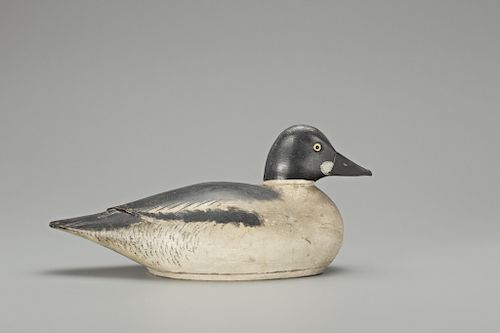Goldeneye Drake, A. Elmer Crowell (1862-1952)
Lot 15
About Seller
Copley Fine Art Auctions
20 Winter Street
Pembroke, MA 02359
United States
Founded in 2005, Copley Fine Art Auctions is a boutique auction house specializing in antique decoys and American, sporting, and wildlife paintings. Over the course of the last two decades, the firm has set auction records for not only individual decoy makers, but also entire carving regions. Copley...Read more
Estimate:
$25,000 - $35,000
Absentee vs Live bid
Two ways to bid:
- Leave a max absentee bid and the platform will bid on your behalf up to your maximum bid during the live auction.
- Bid live during the auction and your bids will be submitted real-time to the auctioneer.
Bid Increments
| Price | Bid Increment |
|---|---|
| $0 | $50 |
| $1,000 | $100 |
| $2,500 | $250 |
| $5,000 | $500 |
| $10,000 | $1,000 |
| $25,000 | $2,500 |
| $50,000 | $5,000 |
About Auction
By Copley Fine Art Auctions
Jul 19, 2018
Set Reminder
2018-07-19 13:00:00
2018-07-19 13:00:00
America/New_York
Bidsquare
Bidsquare : The Sporting Sale 2018, Day 1
https://www.bidsquare.com/auctions/copley/the-sporting-sale-2018-day-1-3286
On July 19, Copley Fine Art Auctions will lead off their annual Sporting Sale with 140 lots from the Donal C. O’Brien, Jr. Collection of Important American Sporting Art and Decoys. On July 20 Copley will present an additional 425 lots of decoys, fish carvings, and sporting art. Copley Fine Art Auctions cinnie@copleyart.com
On July 19, Copley Fine Art Auctions will lead off their annual Sporting Sale with 140 lots from the Donal C. O’Brien, Jr. Collection of Important American Sporting Art and Decoys. On July 20 Copley will present an additional 425 lots of decoys, fish carvings, and sporting art. Copley Fine Art Auctions cinnie@copleyart.com
- Lot Description
Goldeneye Drake
A. Elmer Crowell (1862-1952)
East Harwich, MA, c. 1905
15 1/2 in. long, 6 1/2 in. wide
Hollow Crowell decoys are exceedingly rare. This example with its stunning paint is one of only a handful known to exist. Subtle intricacies of Crowell's best paint show multiple painting techniques employed, including blending to the head, pouncing to the shoulders, and cut-brush stippling to the sides, among others.
This early decoy is in a rare content or tucked-head posture. The back displays Crowell’s refined raised and carved primaries and fluted tail. The head reveals subtle rasping detail. The bottom board bears the Smith family "S” brand with "SW" representing Stanley W. Smith, Esq. (1869-1941) and "AP" representing his brother Albert P. Smith.
The Smiths were descendents of the Mayflower and their decoys are closely linked to the Willard rig of decoys found with the "JWW" brand on the bottom. The "JWW" rig was commissioned by John Ware Willard (1859-1914) who was the grandson of famous clock maker Simon Willard (1753-1848). Decoy historians Linda and Gene Kangas, in their well-researched article, "Connecting the Dots: Exploring the Provenance of Elmer Crowell's Decoys," discovered that the two owners of this decoy, Stanley Smith and Albert Smith, were close to Willard, who mentions the brothers by name in his will.
Excellent original paint with light gunning wear, some touch-up around body seam, and a reset bill.
Provenance: Stanley W. Smith, Esq. and Albert P. Smith Rig
Donal C. O'Brien, Jr. Collection
Literature: Stephen B. O'Brien, Jr. and Chelsie W. Olney, "Elmer Crowell: Father of American Bird Carving," Hingham, MA, 2018, exact bird illustrated.
Linda and Gene Kangas, "Connecting the Dots: Exploring the provenance of Elmer Crowell's decoys," Decoy Magazine, March/April 2010, front cover, pp.30-35, related example.Condition report requests can be made via email or by telephone (info@copleyart.com or 617.536.0030). Any condition statement given is a courtesy to customers, Copley will not be held responsible for any errors or omissions. The absence of a condition statement does not imply that the lot is in perfect condition.Condition
- Shipping Info
-
Shipping info
Copley Fine Art Auctions does not handle the shipping of any items. Shipping is the sole responsibility of the buyer. Once your payment has cleared, and we have received your authorized shipping release form items may be released for shipment. Copley Fine Art Auctions, LLC shall have no liability for any loss or damage to such items. Buyers should allow up to four weeks for shipment.PLEASE BE AWARE THAT INTERNET BIDDERS MAY NOT PICK UP THEIR ITEMS AT THE SALE SITE. ITEMS CAN BE PICKED UP BY APPOINTMENT OR SHIPPED STARTING FIVE DAYS AFTER THE CONCLUSION OF THE SALE
-
- Buyer's Premium



 EUR
EUR CAD
CAD AUD
AUD GBP
GBP MXN
MXN HKD
HKD CNY
CNY MYR
MYR SEK
SEK SGD
SGD CHF
CHF THB
THB















